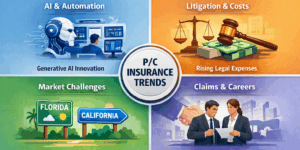
Founders and investors in InsurTech carriers need to prepare themselves—mentally and financially—for a long rough road to profitability, and they need to find reinsurers who are both flexible and prepared for losses, potentially for several years.
Executive Summary
With permission of the authors, Carrier Management is republishing this analysis of the statutory financials of InsurTech insurers Lemonade, Metromile and Root, originally published on LinkedIn, in three parts.In this final part of the series, they offer conclusions about winning strategies of startup insurers.
In Part 1, the authors presented overall loss ratio, expense ratio and combined ratio results from statutory filings of the three insurers. In Part 2, they broke down the startups’ expense spends and discussed the impacts of InsurTech underwriting results on their reinsurers results..
For the complete original article, visit the LinkedIn pages of Matteo Carbone or Adrian Jones.
The 2017 statutory financial results we have presented for Lemonade, Metromile and Root so far in this three-part series of articles suggest that tens of millions will be sunk before it becomes apparent whether the underwriting works, and before it’s clear whether the relationship between customer acquisition costs, fixed expenses, and customer loyalty can produce a sustainable and profitable business.
But there may be a secret to succeeding as an insurance company startup. A look at history may reveals at least one factor that distinguishes the success stories from those that have not endured.
In recent history, the startup insurers that have won were active in markets not targeted by incumbents
Since 2000, at least 34 P/C insurers were formed in the U.S. without the aid of a powerful parent and earned over $10 million in premium in 2016.
Of these 34 startup insurers:
- Twenty-one specialized in high-volatility catastrophic risk like hurricanes or earthquakes. Incumbent carriers have largely stopped or greatly limited their new business in certain catastrophe-exposed regions, sometimes because they felt that regulators or competitors (often government-run pools) did not allow them to charge adequate premiums.
- Nine were motor insurers, mostly nonstandard motor.
- Two don’t have a rating.
- Two remain: Trupanion, a pet insurer, and ReliaMax, which insures student loans.
We readily acknowledge that some carriers aren’t picked up by the screen used for his analysis, such as financial lines companies like Essent. Essent is a Bermuda-based mortgage insurer and reinsurer that wrote $570 million of premium at a 33 combined ratio in 2017 after a standing start in 2008, which might make it one of the most successful U.S.-market insurance startup in the last decade. Other startups were sold along the way, were sponsored by a powerful parent, or purchased an older “shell” and inverted into it.
The point is that successful insurers have rarely won by attacking strong incumbents in their core markets. They have won by figuring out ways to write difficult risks better than incumbents, have created new markets like pet insurance, or have entered seriously dislocated markets with good timing (like writing mortgage insurance in 2009.
This leads to several questions:
- Are urban millennials actually a new market that is being ignored by incumbents?
- Are direct and B2B2C distribution really new markets that incumbents cannot penetrate? Can “platformification” be profitable over the long term?
- How quickly can new/digital systems show cost and pricing benefits over legacy systems that incumbents are retooling aggressively today? How long before the new systems become a legacy for the newcomers that have created them?
- Are new underwriting and claims techniques like the use of big data sufficiently disruptive to allow entry to tightly guarded markets?
There are early signs that all of these questions will be answered favorably for at least a couple of startups, but not without some bumps along the way.
Previous waves of technological changes have allowed new competitors to rise to prominence. Think of the big multiliners that dominated the skyline of Hartford, Conn. with mainframe technology in the ’50s and ’60s, the specialists like WR Berkley built on personal computers in the ’70s and ’80s, and the Bermuda cat specialists of the ’90s and ’00s. Will the next wave of technology-driven insurers include the ones today putting up 150-plus loss ratios? Perhaps.
***
Conclusion
Technology changes a lot, but it doesn’t change fundamental facts that make insurance hard. As we said at the start, we admire and support the companies that choose to become fully-licensed insurers. They have taken the harder path to market but may be more durable in the long term.
To use Matteo’s 4Ps framework to judge any InsurTech initiative—from startups or incumbents, we have yet to know whether/how new challengers can leverage technology to outperform incumbents on technical Profitability, Productivity, Proximity with the clients, and Persistency of the book of business. Whoever is capable of doing this will survive and may be the next big winner in insurance.
InsurTech startup carriers, their investors, and their reinsurers need to be prepared for a long and expensive startup phase. Insurance is a get-rich-slowly business, but it is also a durable business that rewards patience, wise risk-taking, data analysis, and operational excellence.
And for the futurists, disruption evangelists, black swan hunters, and anyone who just learned more about insurance than you ever wanted to know, we hope these dispatches from InsurTech Survival Islandhave been informative for examining startup financials in insurance or other markets where you operate.
Prior articles in this series:
- In Part 1, the authors presented overall loss ratio, expense ratio and combined ratio results from statutory filings of the three insurers.
- In Part 2, they broke down the startups’ expense spends and discussed the impacts of InsurTech underwriting on the books of their reinsurers.
A version of this article, originally titled, “Five Dispatches from InsurTech Survival Island,” was previously published on Mar. 12, 2018 by Matteo Carbone and Adrian Jones on their LinkedIn pages.
The authors’ opinions are solely their own, and only public data was used to create this article.





















 Market Softening Accelerates During 1/1/2026 Re Renewals
Market Softening Accelerates During 1/1/2026 Re Renewals  The Hardest Part of Innovation in Insurance Isn’t Technology; It’s Culture
The Hardest Part of Innovation in Insurance Isn’t Technology; It’s Culture  How Insurers Can Avoid Post-Merger Technology Failure
How Insurers Can Avoid Post-Merger Technology Failure  Why ‘Good Enough’ Is Killing Insurance: The Hidden Cost of Satisficing
Why ‘Good Enough’ Is Killing Insurance: The Hidden Cost of Satisficing 









